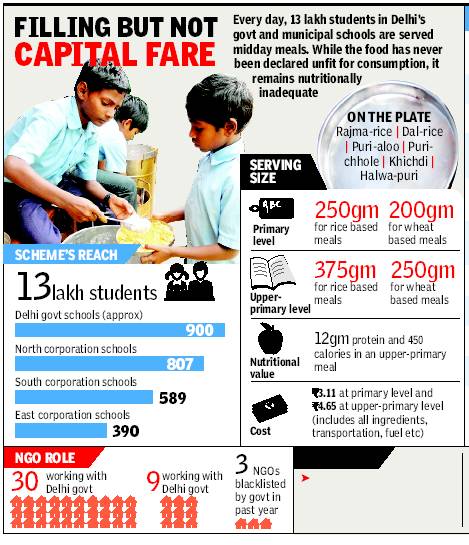Midday Meal Scheme: India
This is a collection of articles archived for the excellence of their content. Readers will be able to edit existing articles and post new articles directly |
Contents |
History
THE GROWING SCHEME
The Times of India 2013/07/18
Aug 15, 1995 | Union govt launches Midday Meal Scheme in 2,408 blocks as a dry rations scheme. Based on scheme running successfully in Tamil Nadu since 1960s. By 1997-98 introduced in all blocks
April 2002 | Cooked meals scheme extended to all Government-assisted primary schools, local body schools
Sept 2006 | Nutrition boost to scheme: Cooked meal with 450 calories, 12g protein to kids in primary classes (I-V)
April 2008 | Scheme expands to include all kids studying in schools and learning-centres like madrassas etc supported under Sarva Shiksha Abhiyan
By 2011-12, Over 2.4 million cooks/helpers mostly women engaged. Over 570,000 kitchens and stores in schools
2013: 10.7 crore children under scheme
Nutritional and hygienic servings have been major challenges in most states
Several scams busted where food-grain is pilfered, poor quality meals served
2012-13: Incidents when food poisoning took place
Midday Meal Scheme in Delhi
QUALITY ISSUES in Delhi
The Times of India 2013/07/19
Meal quality is average and portions are smaller than prescribed size
Many students (7-13%) are not served meals in a day
None of the surveyed schools have kitchen sheds
Potable water is scarce, especially for the 2nd shift boys’ schools
Children are not encouraged to wash their hands before and after meals
Usually, suppliers receive food grains 50 days after supplying meals
Most schools do not display menus or the midday meal logo
Cooks-cum-helpers do not meet government norms
Schools do not discuss the meal scheme with parents Most schools do not maintain a receipts register for meals
(*Findings of the 4th Half-Yearly Monitoring Institution Report (April-September 2012) for the city’s East and Northeast districts)
CONCERNS
Meals deficient in vital vitamins and micro-nutrients.
In 2012, the corporations found 83% meals nutritionally deficient
Service hygiene | Utensils and dining areas often unclean; 3 incidents of food poisoning in the past three years
Budget | Cost per meal should be increased to at least Rs5

